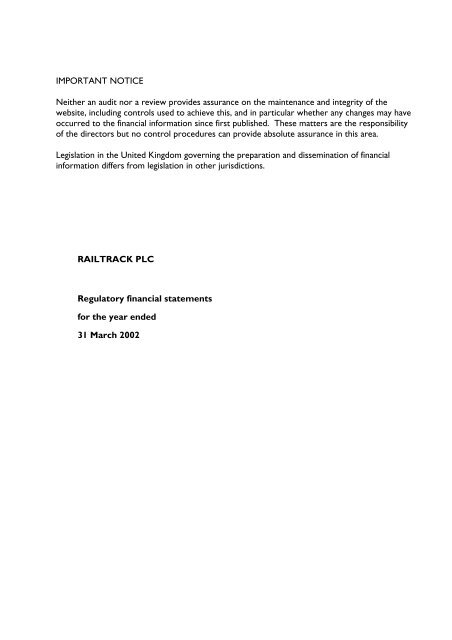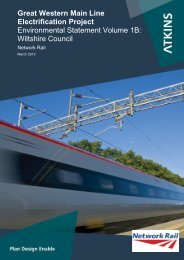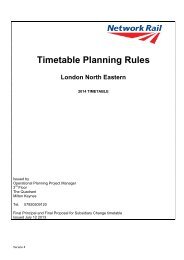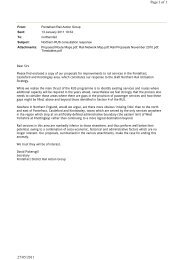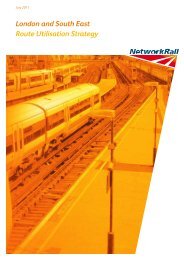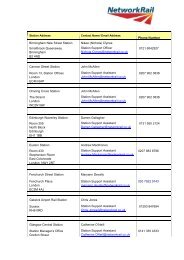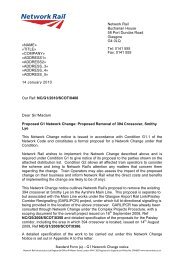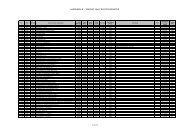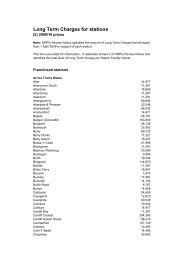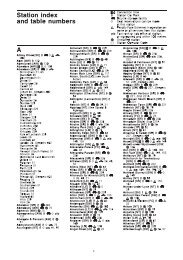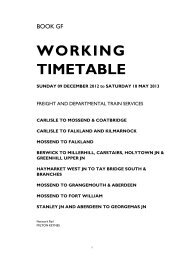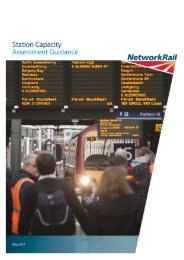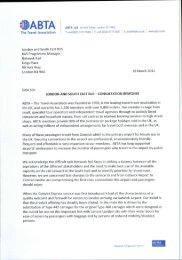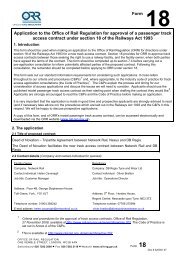Regulatory Financial Statements for the year ended ... - Network Rail
Regulatory Financial Statements for the year ended ... - Network Rail
Regulatory Financial Statements for the year ended ... - Network Rail
You also want an ePaper? Increase the reach of your titles
YUMPU automatically turns print PDFs into web optimized ePapers that Google loves.
IMPORTANT NOTICE<br />
Nei<strong>the</strong>r an audit nor a review provides assurance on <strong>the</strong> maintenance and integrity of <strong>the</strong><br />
website, including controls used to achieve this, and in particular whe<strong>the</strong>r any changes may have<br />
occurred to <strong>the</strong> financial in<strong>for</strong>mation since first published. These matters are <strong>the</strong> responsibility<br />
of <strong>the</strong> directors but no control procedures can provide absolute assurance in this area.<br />
Legislation in <strong>the</strong> United Kingdom governing <strong>the</strong> preparation and dissemination of financial<br />
in<strong>for</strong>mation differs from legislation in o<strong>the</strong>r jurisdictions.<br />
RAILTRACK PLC<br />
<strong>Regulatory</strong> financial statements<br />
<strong>for</strong> <strong>the</strong> <strong>year</strong> <strong>ended</strong><br />
31 March 2002
RAILTRACK PLC<br />
REGULATORY FINANCIAL STATEMENTS 2002<br />
CONTENTS Page<br />
Directors’ review 1<br />
Statement of directors’ responsibilities 6<br />
Independent auditors’ report 7<br />
Part A – Statement of regulatory financial per<strong>for</strong>mance 10<br />
Part B – Statement of regulatory financial position 12<br />
Statement of accounting policies 14<br />
Disclosure statement 1: Tracking <strong>the</strong> RAB and enhancement spend 21<br />
Disclosure statement 2: Adjustments <strong>for</strong> non-enhancements 23<br />
Disclosure statement 3: Income statement 25<br />
Disclosure statement 4: Expenditure statement 26<br />
Disclosure statement 5: Renewals and Maintenance Costs by Asset 28<br />
Disclosure statement 6: Property allowance scheme 29<br />
Disclosure statement 7: Segmental Analysis 30<br />
Disclosure statement 8: Grants 31<br />
Appendix A Reconciliation of statutory operating profit to regulatory total<br />
operating return 32<br />
Appendix B: Reconciliation of statutory net assets to regulatory net assets 33
RAILTRACK PLC<br />
REGULATORY FINANCIAL STATEMENTS 2002<br />
CONTENTS Page<br />
Appendix C: Reconciliation of statutory fixed assets to regulatory fixed<br />
assets 34<br />
Appendix D: O<strong>the</strong>r notes 35
RAILTRACK PLC<br />
DIRECTORS’ REVIEW<br />
The Directors of <strong>Rail</strong>track PLC are pleased to present <strong>the</strong> regulatory financial statements <strong>for</strong><br />
<strong>the</strong> <strong>year</strong> <strong>ended</strong> 31 March 2002. The basis of preparation of <strong>the</strong>se financial statements is<br />
significantly different to <strong>the</strong> basis used to prepare <strong>the</strong> statutory financial statements and is<br />
explained in detail below and in <strong>the</strong> accounting policies note.<br />
<strong>Regulatory</strong> financial per<strong>for</strong>mance<br />
The actual net regulatory asset base (“RAB”) operating return <strong>for</strong> <strong>the</strong> <strong>year</strong> <strong>ended</strong> 31 March<br />
2002 was £601 million compared with that in <strong>the</strong> Periodic Review of <strong>Rail</strong>track’s Access<br />
Charges: Final Conclusions published by <strong>the</strong> <strong>Rail</strong> Regulator in October 2000 (“<strong>the</strong> regulatory<br />
determination”) of £488 million.<br />
The RAB operating return reflects a 9.8% return on <strong>the</strong> average RAB, compared to <strong>the</strong> <strong>Rail</strong><br />
Regulator’s expected return of 8%. The increased return is as a result of excess property<br />
profits of £40 million (which are subject to clawback under <strong>the</strong> property allowance scheme)<br />
and various incentives of £66 million and enhancement overspend written back to RAB of £39<br />
million.<br />
The total operating return <strong>for</strong> <strong>the</strong> <strong>year</strong>, which includes income and expenditure on assets that<br />
are outside of <strong>the</strong> regulatory asset base, was £578 million. This total operating return of<br />
£578 million compares to a reported operating loss in <strong>the</strong> company’s statutory accounts <strong>for</strong> <strong>the</strong><br />
<strong>year</strong> <strong>ended</strong> 31 March 2002 of £1,078 million. A full reconciliation of <strong>the</strong> differences between<br />
<strong>the</strong>se results is provided in Appendix A.<br />
The most significant difference to note between <strong>the</strong> two sets of results is that, following <strong>the</strong><br />
<strong>Rail</strong> Regulator’s statement of 27 June 2002 in respect of <strong>the</strong> acquisition of <strong>Rail</strong>track PLC by<br />
<strong>Network</strong> <strong>Rail</strong>, all renewals, maintenance, per<strong>for</strong>mance and o<strong>the</strong>r operating expenditure in<br />
excess of <strong>the</strong> amounts allowed by <strong>the</strong> regulatory determination <strong>for</strong> <strong>the</strong> <strong>year</strong> <strong>ended</strong> 31 March<br />
2002 has been included as an increase in <strong>the</strong> RAB (as an adjustment carried <strong>for</strong>ward to <strong>the</strong> next<br />
valuation of RAB in 2006) and treated as regulatory income (or a reduction in regulatory<br />
expenditure) in <strong>the</strong> regulatory financial statements. A similar treatment is not possible when<br />
preparing statutory financial statements as <strong>the</strong> excess expenditure on renewals, maintenance<br />
and schedule 8 per<strong>for</strong>mance penalties has not enhanced <strong>the</strong> company’s fixed assets, and thus<br />
<strong>the</strong> increase in <strong>the</strong> RAB will only result in higher income in later <strong>year</strong>s when <strong>the</strong> company<br />
receives commensurately higher access charges.<br />
<strong>Regulatory</strong> financial position<br />
The regulatory financial position of <strong>the</strong> company shows a total regulated asset valuation of<br />
£8,590 million compared with a regulatory determination of £7,356 million. The difference<br />
between <strong>the</strong> totals reflects <strong>the</strong> RAB adjustments that will be included in <strong>the</strong> 2006 RAB<br />
valuation, as permitted by <strong>the</strong> <strong>Rail</strong> Regulator’s statement of 27 June 2002 explained above.<br />
Reasons <strong>for</strong> <strong>the</strong> excess spend are given below.<br />
The ‘logged up’ valuation of <strong>the</strong> RAB at 31 March 2002 is £6,394 million which is £49 million<br />
higher than <strong>the</strong> regulatory determination of £6,345 million. The net total regulatory assets of<br />
<strong>Rail</strong>track PLC at 31 March were £1,882 million compared with net assets reported in <strong>the</strong><br />
statutory financial statements of £1,182 million. A net assets reconciliation is provided in<br />
Appendix B, with a reconciliation of <strong>the</strong> RAB and ring fenced assets to statutory fixed assets in<br />
Appendix C.<br />
1
RAILTRACK PLC<br />
DIRECTORS’ REVIEW<br />
Material variations from <strong>the</strong> regulatory determination<br />
Income<br />
The main variance from <strong>the</strong> regulatory determination in terms of income is created by <strong>the</strong><br />
impact of schedule 8 and schedule 4 per<strong>for</strong>mance costs which have reduced franchise access<br />
income by £411 million. This is a reflection of <strong>the</strong> work undertaken to regain control of <strong>the</strong><br />
network post-Hatfield, outlined fur<strong>the</strong>r below. The overall income variance compared with <strong>the</strong><br />
determination is a positive variance of £73 million, as a consequence of <strong>the</strong> subsequent logging<br />
up of schedule 8 and schedule 4 costs as an adjustment to RAB in accordance with <strong>the</strong> <strong>Rail</strong><br />
Regulator’s statement of 27 June 2002, excess property profits and various incentive revenues.<br />
Expenditure<br />
The overall expenditure variance, be<strong>for</strong>e taking account of <strong>the</strong> <strong>Rail</strong> Regulator’s statement, was a<br />
negative variance of £566 million. The most significant factors that have caused this<br />
expenditure variance are:<br />
• Track renewals and maintenance have been subject to a complete review since<br />
Hatfield as <strong>Rail</strong>track regained engineering control of <strong>the</strong> network. Key drivers <strong>for</strong> <strong>the</strong><br />
increase in track renewals expenditure include an improved understanding of <strong>the</strong> condition<br />
of track assets and new in<strong>for</strong>mation on <strong>the</strong> rate of degradation of track assets (including <strong>the</strong><br />
emergence of Gauge Corner Cracking). The underlying drivers <strong>for</strong> <strong>the</strong> increase in<br />
maintenance include compliance with new (or clarified) standards, particularly in <strong>the</strong><br />
aftermath of Hatfield, new maintenance activities as a result of fur<strong>the</strong>r research undertaken<br />
following Hatfield (including rail grinding, train-borne ultrasonic inspections and <strong>the</strong><br />
installation of new lubricators), <strong>the</strong> roll out of <strong>the</strong> Maintenance In<strong>for</strong>mation Management<br />
System work management system and <strong>the</strong> impact of changing activity levels on unit costs.<br />
• Train control renewals, which comprises signalling and telecoms renewals, where <strong>the</strong><br />
company has significantly underspent <strong>the</strong> regulatory determination. This reflects slower<br />
than originally planned development of <strong>the</strong> Fixed Telecom <strong>Network</strong> and GSM-R and<br />
deferral of signalling expenditure, particularly on <strong>the</strong> West Coast Route Modernisation<br />
(“WCRM”) programme as <strong>the</strong> scope <strong>for</strong> Phase II has developed.<br />
• O<strong>the</strong>r costs, which comprise staff costs and o<strong>the</strong>r production and management costs have<br />
risen as a result of various items, particularly increased headcount (an 8% rise on <strong>the</strong><br />
previous <strong>year</strong>), <strong>the</strong> increased pension charges <strong>for</strong> <strong>the</strong> <strong>Rail</strong>track section of <strong>the</strong> <strong>Rail</strong>ways<br />
Pension Scheme as a consequence of a general fall in investment values, as well as <strong>the</strong><br />
impact of provisions against claims, <strong>the</strong> increased costs of insurance and some feasibility<br />
costs written off.<br />
RAB and RAB adjustments <strong>for</strong> 2006<br />
As outlined below, adjustments <strong>for</strong> amounts spent in excess of <strong>the</strong> regulatory determination<br />
have been incorporated into <strong>the</strong> RAB as an accumulated adjustment carried <strong>for</strong>ward to 2006,<br />
though any adjustment may be reflected earlier in <strong>the</strong> event of an interim review or an early<br />
periodic review. These adjustments total some £1,015 million. The reasons <strong>for</strong> <strong>the</strong> overspend<br />
are outlined above. In addition, o<strong>the</strong>r adjustments in respect of freight income shortfall<br />
following <strong>the</strong> withdrawal of <strong>the</strong> associated grant, volume, congestion, and broken rail incentives,<br />
deferred income and property renewals total £308 million. These latter income adjustments are<br />
2
RAILTRACK PLC<br />
DIRECTORS’ REVIEW<br />
entirely offset by <strong>the</strong> effect of <strong>the</strong> additional network grant of £351 million which has been<br />
received in advance of 2006 and, as such has been anticipated as a reduction in RAB.<br />
3
RAILTRACK PLC<br />
DIRECTORS’ REVIEW<br />
Basis of preparation<br />
<strong>Regulatory</strong> financial statements are required to be prepared by <strong>Rail</strong>track PLC under <strong>the</strong> terms<br />
of its <strong>Network</strong> Licence dated 31 March 1994, as am<strong>ended</strong> on 11 April 2001, ("<strong>the</strong> Licence").<br />
This is a requirement which came into effect <strong>for</strong> <strong>Regulatory</strong> Control Period 2 (“CP2”),<br />
commencing on 1 April 2001, and <strong>the</strong>se are <strong>the</strong>re<strong>for</strong>e <strong>the</strong> first set of regulatory financial<br />
statements. The <strong>for</strong>m of <strong>the</strong> regulatory financial statements is specified in Condition 22 of <strong>the</strong><br />
Licence and <strong>the</strong> statements must be prepared in accordance with detailed <strong>Regulatory</strong><br />
Accounting Guidelines issued by <strong>the</strong> Regulator in accordance with Condition 22.<br />
The regulatory financial statements are prepared on a basis which differs significantly from UK<br />
generally accepted accounting principles (“UK GAAP”). <strong>Rail</strong>track PLC's statutory accounts <strong>for</strong><br />
<strong>the</strong> <strong>year</strong> <strong>ended</strong> 31 March 2002 have been filed with <strong>the</strong> Registrar of Companies and were<br />
prepared in accordance with UK GAAP. Appendix A includes a reconciliation of <strong>the</strong> operating<br />
loss in <strong>the</strong> statutory accounts to <strong>the</strong> total operating return reported in <strong>the</strong> regulatory financial<br />
statements.<br />
The detailed regulatory accounting policies adopted are set out after <strong>the</strong> statement of<br />
regulatory financial position.<br />
Fundamental Uncertainty – West Coast Route Modernisation (“WCRM”)<br />
In preparing <strong>the</strong> regulatory financial statements <strong>the</strong> directors have considered a fundamental<br />
uncertainty relating to WCRM. During <strong>the</strong> <strong>year</strong> <strong>the</strong> company has been seeking an agreement<br />
with Virgin Trains Limited (“Virgin”), <strong>the</strong> Strategic <strong>Rail</strong> Authority (“SRA”) and <strong>the</strong> <strong>Rail</strong><br />
Regulator on a revised contract and output specification in respect of WCRM. At <strong>the</strong> date of<br />
approval of <strong>the</strong> regulatory financial statements <strong>the</strong> SRA is conducting a review of <strong>the</strong> optimal<br />
capacity utilisation of <strong>the</strong> West Coast Main Line and of <strong>the</strong> infrastructure necessary to support<br />
this capacity.<br />
There is a fundamental uncertainty as to <strong>the</strong> outcome of this review and it is not possible to<br />
quantify with any certainty <strong>the</strong> potential final costs of <strong>the</strong> project including any settlement with<br />
Virgin nor <strong>the</strong> extent to which <strong>the</strong> costs may need to be provided against in <strong>the</strong> regulatory<br />
financial statements at 31 March 2002. In <strong>the</strong> opinion of <strong>the</strong> directors it would be seriously<br />
prejudicial <strong>for</strong> <strong>the</strong> company to attempt to disclose any fur<strong>the</strong>r in<strong>for</strong>mation about <strong>the</strong><br />
uncertainties or <strong>the</strong> potential financial effect of possible outcomes.<br />
Post balance sheet events<br />
In a statement dated 27 June 2002 <strong>the</strong> <strong>Rail</strong> Regulator published his views on <strong>the</strong> proposed<br />
acquisition of <strong>Rail</strong>track PLC by <strong>Network</strong> <strong>Rail</strong> and outlined <strong>the</strong> licence modifications which he<br />
would propose to make on completion of <strong>the</strong> transaction. The statement set out, inter alia, <strong>the</strong><br />
<strong>Rail</strong> Regulator’s views on <strong>the</strong> additional funding which would be required by <strong>Rail</strong>track PLC over<br />
<strong>the</strong> remainder of CP2. The <strong>Rail</strong> Regulator indicated that he proposes making certain<br />
adjustments to <strong>the</strong> RAB to reflect additional expenditure on operating, maintaining and<br />
renewing <strong>the</strong> network in <strong>the</strong> two <strong>year</strong>s <strong>ended</strong> 31 March 2003 matched by an increase in <strong>the</strong><br />
RAB, of which £1,015 million has been recorded in <strong>the</strong> <strong>year</strong> <strong>ended</strong> 31 March 2002. On 1<br />
October 2002 <strong>the</strong> High Court ordered that <strong>Rail</strong>track PLC be discharged from administration,<br />
which was <strong>the</strong> final condition precedent in <strong>the</strong> <strong>Network</strong> <strong>Rail</strong> sale agreement. The company<br />
became a subsidiary of <strong>Network</strong> <strong>Rail</strong> Limited on 3 October 2002.<br />
4
RAILTRACK PLC<br />
DIRECTORS’ REVIEW<br />
On 27 June 2002 <strong>the</strong> company’s <strong>for</strong>mer parent undertaking, <strong>Rail</strong>track Group PLC, entered into<br />
an agreement with <strong>Network</strong> <strong>Rail</strong> Limited and <strong>Network</strong> <strong>Rail</strong> Limited and <strong>Network</strong> <strong>Rail</strong> Holdco<br />
Limited (toge<strong>the</strong>r “<strong>Network</strong> <strong>Rail</strong>”) <strong>for</strong> <strong>the</strong> sale and purchase of <strong>the</strong> entire issued share capital<br />
of <strong>Rail</strong>track PLC.<br />
On 19 August 2002 <strong>the</strong> company purchased <strong>the</strong> entire issue share capital of <strong>Rail</strong>track (Spacia)<br />
Limited <strong>for</strong> a consideration of £17 million.<br />
By order of <strong>the</strong> board<br />
John Armitt Ron Henderson<br />
5
RAILTRACK PLC<br />
STATEMENT OF DIRECTORS’ RESPONSIBILITIES<br />
The directors are responsible <strong>for</strong> preparing regulatory financial statements in accordance with<br />
Condition 22 of <strong>the</strong> <strong>Network</strong> Licence dated 31 March 1994, as am<strong>ended</strong> on 11 April 2001.<br />
In preparing those regulatory financial statements, <strong>the</strong> directors are required by Condition 22<br />
to:<br />
• prepare <strong>the</strong> regulatory financial statements in respect of <strong>the</strong> <strong>year</strong> <strong>ended</strong> 31 March 2002 and<br />
(save as o<strong>the</strong>rwise provided in Condition 22 or <strong>the</strong> <strong>Regulatory</strong> Accounting Guidelines)<br />
<strong>the</strong>reafter on a consistent basis in respect of each succeeding <strong>year</strong>;<br />
• prepare <strong>the</strong> regulatory financial statements such that, insofar as reasonably practical, <strong>the</strong><br />
definition of items in primary statements; <strong>the</strong> valuation of assets and liabilities; <strong>the</strong><br />
treatment of income and expenditure as capital or revenue; adjustments in respect of <strong>the</strong><br />
provision, utilisation, depreciation and amortisation of assets and liabilities; and any o<strong>the</strong>r<br />
relevant accounting policies shall be consistent with:<br />
(i) <strong>the</strong> Regulator’s valuation of <strong>the</strong> <strong>Regulatory</strong> Asset Base <strong>for</strong> <strong>the</strong> purpose of<br />
determining access charges; and<br />
(ii) <strong>the</strong> Determination Assumptions <strong>for</strong> <strong>the</strong> corresponding period as defined in<br />
Condition 22;<br />
(and so that where <strong>the</strong> presentation of an item in <strong>the</strong> primary statements departs<br />
from <strong>the</strong> basis <strong>for</strong> <strong>the</strong> <strong>Regulatory</strong> Asset Base or <strong>the</strong> Determination Assumptions, a<br />
reconciliation shall be included by way of a note);<br />
• include, as a primary statement, a statement of regulatory financial per<strong>for</strong>mance comparing<br />
income, expenditure, profits and losses <strong>for</strong> <strong>the</strong> period with <strong>the</strong> Determination<br />
Assumptions;<br />
• include all details reasonably necessary to reconcile in <strong>the</strong> primary statements with <strong>the</strong><br />
annual statutory accounts <strong>for</strong> <strong>the</strong> same period.<br />
In addition <strong>the</strong> directors are responsible <strong>for</strong> selecting suitable accounting policies where <strong>the</strong>se<br />
are not directed by <strong>Regulatory</strong> Accounting Guidelines and <strong>for</strong> making judgements and estimates<br />
that are reasonable and prudent.<br />
The board of directors are also required to <strong>for</strong>mally approve <strong>the</strong> regulatory financial<br />
statements by signing <strong>the</strong> regulatory financial statements, comprising part A and part B of <strong>the</strong><br />
regulatory financial per<strong>for</strong>mance.<br />
In accordance with <strong>the</strong> <strong>Regulatory</strong> Accounting Guidelines <strong>the</strong> statutory financial statements are<br />
included as an attachment to <strong>the</strong>se regulatory financial statements to enable a comparison. It<br />
should be noted that <strong>the</strong>se statutory financial statements, which do not <strong>for</strong>m a part of <strong>the</strong><br />
regulatory financial statements, are covered by a separate audit engagement and opinion and<br />
are included <strong>for</strong> in<strong>for</strong>mation only.<br />
6
INDEPENDENT AUDITORS’ REPORT TO RAILTRACK PLC AND THE OFFICE<br />
OF THE RAIL REGULATOR<br />
In accordance with our terms of engagement dated 15 October 2002, we have audited <strong>the</strong><br />
regulatory financial statements of <strong>Rail</strong>track PLC <strong>for</strong> <strong>the</strong> <strong>year</strong> <strong>ended</strong> 31 March 2002 which<br />
comprise <strong>the</strong> statement of regulatory financial per<strong>for</strong>mance, <strong>the</strong> statement of regulatory<br />
financial position, <strong>the</strong> statement of accounting policies, <strong>the</strong> related disclosure statements 1 to 8<br />
and <strong>the</strong> related appendices A to D.<br />
The regulatory financial statements are separate from <strong>the</strong> statutory financial statements and<br />
have been prepared under <strong>the</strong> accounting policies set out <strong>the</strong>rein which differ significantly from<br />
UK generally accepted accounting principles (“UK GAAP”). <strong>Financial</strong> in<strong>for</strong>mation o<strong>the</strong>r than<br />
that prepared on <strong>the</strong> basis of UK GAAP does not necessarily represent a true and fair view of<br />
<strong>the</strong> financial per<strong>for</strong>mance or financial position of a company.<br />
Respective responsibilities of directors and auditors<br />
The nature, <strong>for</strong>m and content of <strong>the</strong> regulatory financial statements are determined by <strong>the</strong><br />
requirements of <strong>the</strong> Office of <strong>the</strong> <strong>Rail</strong> Regulator (“ORR”). It is not appropriate <strong>for</strong> <strong>the</strong> auditors<br />
or <strong>the</strong> directors to assess whe<strong>the</strong>r <strong>the</strong> nature of <strong>the</strong> in<strong>for</strong>mation being reported upon is<br />
suitable or appropriate <strong>for</strong> <strong>the</strong> ORR’s purposes. Accordingly, we make no such assessment.<br />
As described in <strong>the</strong> statement of directors’ responsibilities, <strong>the</strong> company’s directors are<br />
responsible <strong>for</strong> <strong>the</strong> preparation of <strong>the</strong> regulatory financial statements in accordance with<br />
Condition 22 of <strong>Rail</strong>track PLC’s network licence dated 31 March 1994 as am<strong>ended</strong> on 11 April<br />
2001 (“Condition 22”) and <strong>the</strong> regulatory accounting guidelines issued on 11 October 2002 in<br />
accordance with Condition 22 and subsequent additional guidance provided by <strong>the</strong> Office of <strong>the</strong><br />
<strong>Rail</strong> Regulator (“<strong>the</strong> <strong>Regulatory</strong> Accounting Guidelines”). Our responsibility, as set out in our<br />
terms of engagement, is to audit <strong>the</strong> regulatory financial statements in accordance with those<br />
terms, relevant United Kingdom auditing standards and Condition 22.<br />
We report to you our opinion as to whe<strong>the</strong>r <strong>the</strong> regulatory financial statements present fairly<br />
<strong>the</strong> regulatory financial per<strong>for</strong>mance of <strong>Rail</strong>track PLC <strong>for</strong> <strong>the</strong> <strong>year</strong> <strong>ended</strong> 31 March 2002 and<br />
<strong>the</strong> regulatory financial position as at that date in accordance with <strong>the</strong> requirements of<br />
Condition 22 and <strong>the</strong> <strong>Regulatory</strong> Accounting Guidelines and have been prepared in accordance<br />
with those same requirements. We also report to you if, in our opinion, <strong>the</strong> Company has not<br />
kept proper accounting records, <strong>the</strong> regulatory financial statements are not in agreement with<br />
<strong>the</strong> underlying accounting records and regulatory returns, or if we have not received all <strong>the</strong><br />
in<strong>for</strong>mation and explanations we require <strong>for</strong> our audit.<br />
We read <strong>the</strong> Directors’ Review and consider <strong>the</strong> implications <strong>for</strong> our report if we become<br />
aware of any apparent misstatements or material inconsistencies with <strong>the</strong> regulatory financial<br />
statements.<br />
Our report is prepared solely <strong>for</strong> <strong>the</strong> confidential use of <strong>Rail</strong>track PLC and <strong>the</strong> Office of <strong>the</strong><br />
<strong>Rail</strong> Regulator, and solely <strong>for</strong> <strong>the</strong> purpose of <strong>Rail</strong>track PLC’s compliance with <strong>the</strong> obligations of<br />
its licence. It may not be relied upon by you <strong>for</strong> any o<strong>the</strong>r purpose whatsoever. Deloitte &<br />
Touche nei<strong>the</strong>r owes nor accepts any duty to any o<strong>the</strong>r party and shall not be liable <strong>for</strong> loss,<br />
damage or expense of whatsoever nature which is caused by <strong>the</strong>ir reliance on our report.<br />
7
Basis of audit opinion<br />
We conducted our audit in accordance with United Kingdom auditing standards issued by <strong>the</strong><br />
Auditing Practices Board. An audit includes examination, on a test basis, of evidence relevant to<br />
<strong>the</strong> amounts and disclosures in <strong>the</strong> regulatory financial statements. It also includes an<br />
assessment of <strong>the</strong> significant estimates and judgements made by <strong>the</strong> directors in <strong>the</strong> preparation<br />
of <strong>the</strong> regulatory financial statements. It does not include an assessment of whe<strong>the</strong>r <strong>the</strong><br />
accounting policies are appropriate to <strong>the</strong> circumstances of <strong>the</strong> company where <strong>the</strong>se are laid<br />
down by <strong>the</strong> <strong>Regulatory</strong> Accounting Guidelines. Where <strong>the</strong> <strong>Regulatory</strong> Accounting Guidelines<br />
do not give specific guidance on <strong>the</strong> accounting policies to be followed, our audit includes an<br />
assessment of whe<strong>the</strong>r <strong>the</strong> accounting policies adopted in respect of <strong>the</strong> transactions and<br />
balances required to be included in <strong>the</strong> regulatory financial statements are consistent with those<br />
used in <strong>the</strong> preparation of <strong>the</strong> statutory financial statements of <strong>Rail</strong>track PLC.<br />
8
We planned and per<strong>for</strong>med our audit so as to obtain all <strong>the</strong> in<strong>for</strong>mation and explanations which<br />
we considered necessary in order to provide us with sufficient evidence to give reasonable<br />
assurance that <strong>the</strong> regulatory financial statements are free from material misstatement, whe<strong>the</strong>r<br />
caused by fraud or o<strong>the</strong>r irregularity or error. In <strong>for</strong>ming our opinion, we also evaluated<br />
whe<strong>the</strong>r <strong>the</strong> presentation of in<strong>for</strong>mation in <strong>the</strong> regulatory financial statements was adequate<br />
overall to comply with <strong>the</strong> <strong>Regulatory</strong> Accounting Guidelines.<br />
Our opinion on <strong>the</strong> regulatory financial statements is separate from our opinion on <strong>the</strong><br />
statutory financial statements of <strong>the</strong> company, which are prepared <strong>for</strong> a different purpose.<br />
Fundamental uncertainty<br />
In <strong>for</strong>ming our opinion, we have considered <strong>the</strong> adequacy of disclosures made in <strong>the</strong> statement<br />
of accounting policies included in <strong>the</strong> regulatory financial statements, concerning a fundamental<br />
uncertainty relating to <strong>the</strong> West Coast Route Modernisation (“WCRM”). During <strong>the</strong> <strong>year</strong> <strong>the</strong><br />
company has been seeking an agreement with Virgin Trains Limited (“Virgin”), <strong>the</strong> Strategic <strong>Rail</strong><br />
Authority (“SRA”) and <strong>the</strong> Office of <strong>the</strong> <strong>Rail</strong> Regulator on a revised contract and output<br />
specification in respect of <strong>the</strong> WCRM. At <strong>the</strong> date of approval of <strong>the</strong> regulatory financial<br />
statements <strong>the</strong> SRA is conducting a review of <strong>the</strong> optimal capacity utilisation of <strong>the</strong> West Coast<br />
Mainline and <strong>the</strong> infrastructure necessary to support this capacity.<br />
There is a fundamental uncertainty as to <strong>the</strong> outcome of this review and it is <strong>the</strong>re<strong>for</strong>e not<br />
possible to quantify with any certainty <strong>the</strong> potential final costs of <strong>the</strong> project including any<br />
settlement with Virgin or <strong>the</strong> extent to which <strong>the</strong>y would need to be provided <strong>for</strong> in <strong>the</strong><br />
statement of regulatory per<strong>for</strong>mance or <strong>the</strong> statement of regulatory financial position at 31<br />
March 2002. Our opinion is not qualified in this respect.<br />
Opinion<br />
In our opinion <strong>the</strong> regulatory financial statements present fairly <strong>the</strong> regulatory financial<br />
per<strong>for</strong>mance of <strong>Rail</strong>track PLC <strong>for</strong> <strong>the</strong> <strong>year</strong> <strong>ended</strong> 31 March 2002 and <strong>the</strong> regulatory financial<br />
position as at that date, and have been prepared, in accordance with <strong>the</strong> requirements of<br />
Condition 22 and <strong>the</strong> <strong>Regulatory</strong> Accounting Guidelines.<br />
Deloitte & Touche<br />
Chartered Accountants<br />
London<br />
29 November 2002<br />
9
RAILTRACK PLC<br />
PART A – STATEMENT OF REGULATORY FINANCIAL PERFORMANCE<br />
Year <strong>ended</strong> 31 March 2002<br />
Notes Actual<br />
per<strong>for</strong>ma<br />
nce<br />
2001/02<br />
£m<br />
ORR<br />
determinat<br />
ion<br />
2001/02<br />
£m<br />
Differen<br />
ce<br />
2001/02<br />
£m<br />
INCOME<br />
Franchise access DS3 1,256 1,707 (451)<br />
O<strong>the</strong>r single till DS3 444 541 (97)<br />
Property income DS3 267 227 40<br />
Adjustment c/f in 2006 RAB DS2 709 128 581<br />
<strong>Network</strong> grant DS2 877 877 -<br />
X-profiling accruals DS2 458 458 -<br />
Total 4,011 3,938 73<br />
EXPENDITURE<br />
Renewals DS4 (1,911) (1,834) (77)<br />
Maintenance DS4 (951) (691) (260)<br />
Opex own costs DS4 (860) (605) (255)<br />
Joint industry costs DS4 (294) (320) 26<br />
Adjustment c/f in 2006 RAB DS2 561 - 561<br />
Total (3,455) (3,450) (5)<br />
RAB ADJUSTMENTS<br />
RAB depreciation - - -<br />
Project gains and losses 39 - 39<br />
Capitalised financing 6 - 6<br />
Total 45 - 45<br />
NET RAB OPERATING RETURN 601 488 113<br />
CAPITALISED FINANCING OF<br />
REGULATORY ACCRUALS AND<br />
GRANTS 82<br />
RING-FENCED ACTIVITIES<br />
Ring-fenced revenues -<br />
Project gains and losses (139)<br />
Capitalised financing 34<br />
Return on ring-fenced activities (105)<br />
TOTAL OPERATING RETURN 578<br />
INTEREST AND INFLATION<br />
ADJUSTMENTS<br />
Interest (385)<br />
Decrease in market value of debt 62<br />
Inflation adjustment to RAB and o<strong>the</strong>r items 99<br />
(224)<br />
10
RAILTRACK PLC<br />
PART A – STATEMENT OF REGULATORY FINANCIAL PERFORMANCE<br />
Year <strong>ended</strong> 31 March 2002<br />
TOTAL RETURN BEFORE TAXATION 354<br />
Corporation tax prior <strong>year</strong> overprovision 20<br />
Deferred taxation -<br />
TOTAL RETURN AFTER TAXATION 374<br />
Approved by order of <strong>the</strong> board of directors on 29 No<br />
Signed on behalf of <strong>the</strong> board of directors<br />
John Armitt Ron Henderson<br />
11
RAILTRACK PLC<br />
PART B – STATEMENT OF REGULATORY FINANCIAL POSITION<br />
Year <strong>ended</strong> 31 March 2002<br />
Notes Actual<br />
per<strong>for</strong>ma<br />
nce<br />
2001/02<br />
£m<br />
ORR<br />
determinati<br />
on<br />
2001/02<br />
£m<br />
Differenc<br />
e<br />
2001/02<br />
£m<br />
ASSET BASE ANALYSIS<br />
RAB DS1 6,394 6,345 49<br />
Deferred network grants DS2 746 749 (3)<br />
Advance grant payments DS2 (351) (350) (1)<br />
RAB adjustments <strong>for</strong> 2006 DS2 1,323 134 1,189<br />
X-profiling DS2 478 478 -<br />
Regulated total 8,590 7,356 1,234<br />
Ring-fenced and o<strong>the</strong>r assets DS1 538<br />
Working capital<br />
Working capital amount included in initial<br />
9,128<br />
(1,290)<br />
RAB<br />
478<br />
Net operating assets 8,316<br />
Net debt (6,423)<br />
Tax balances - Deferred taxation -<br />
– Corporation tax App D (11)<br />
Net total regulatory assets 1,882<br />
Average RAB 6,119 6,090 29<br />
NET RAB OPERATING RETURN ON<br />
AVERAGE RAB<br />
Average net total regulatory assets 1,695<br />
TOTAL RETURN ON AVERAGE NET<br />
TOTAL REGULATORY ASSETS<br />
9.8% 8.0% 1.8%<br />
22.1%<br />
Approved by order of <strong>the</strong> board of directors on 29 November 2002<br />
Signed on behalf of <strong>the</strong> board of directors<br />
12
RAILTRACK PLC<br />
PART B – STATEMENT OF REGULATORY FINANCIAL POSITION<br />
Year <strong>ended</strong> 31 March 2002<br />
John Armitt Ron Henderson<br />
13
RAILTRACK PLC<br />
STATEMENT OF ACCOUNTING POLICIES<br />
Year <strong>ended</strong> 31 March 2002<br />
<strong>Regulatory</strong> financial statements are required to be prepared by <strong>Rail</strong>track PLC under <strong>the</strong> terms<br />
of its <strong>Network</strong> Licence dated 31 March 1994, as am<strong>ended</strong> on 11 April 2001, ("<strong>the</strong> Licence").<br />
This is a requirement which came into effect <strong>for</strong> <strong>Regulatory</strong> Control Period 2, commencing on<br />
1 April 2001, and <strong>the</strong>se are <strong>the</strong>re<strong>for</strong>e <strong>the</strong> first set of regulatory financial statements. The <strong>for</strong>m<br />
of <strong>the</strong> regulatory financial statements is specified in Condition 22 of <strong>the</strong> Licence and <strong>the</strong><br />
statements must be prepared in accordance with detailed <strong>Regulatory</strong> Accounting Guidelines<br />
issued by <strong>the</strong> Regulator in accordance with Condition 22.<br />
The regulatory financial statements are prepared on a basis which differs significantly from UK<br />
generally accepted accounting principles (“UK GAAP”) and do not constitute statutory<br />
accounts within <strong>the</strong> meaning of Section 240 of <strong>the</strong> Companies Act 1985. <strong>Rail</strong>track PLC’s<br />
statutory accounts <strong>for</strong> <strong>the</strong> <strong>year</strong> <strong>ended</strong> 31 March 2002 have been filed with <strong>the</strong> Registrar of<br />
Companies and were prepared in accordance with UK GAAP. The report of <strong>the</strong> auditors on<br />
<strong>the</strong> accounts filed with <strong>the</strong> Registrar of Companies was unqualified and did not contain a<br />
statement under Section 237(2) or (3) of <strong>the</strong> Companies Act 1985. Appendix A includes a<br />
reconciliation of <strong>the</strong> loss in <strong>the</strong> statutory accounts to <strong>the</strong> total operating return reported in <strong>the</strong><br />
regulatory financial statements.<br />
Fundamental uncertainty – West Coast Route Modernisation (“WCRM”)<br />
In preparing <strong>the</strong> regulatory financial statements <strong>the</strong> directors have considered a fundamental<br />
uncertainty relating to WCRM. During <strong>the</strong> <strong>year</strong> <strong>the</strong> company has been seeking an agreement<br />
with Virgin Trains Limited (“Virgin”), <strong>the</strong> Strategic <strong>Rail</strong> Authority (“SRA”) and <strong>the</strong> <strong>Rail</strong><br />
Regulator on a revised contract and output specification in respect of WCRM. At <strong>the</strong> date of<br />
approval of <strong>the</strong> financial statements <strong>the</strong> SRA is conducting a review of <strong>the</strong> optimal capacity<br />
utilisation of <strong>the</strong> West Coast Mainline and of <strong>the</strong> infrastructure necessary to support this<br />
capacity.<br />
There is a fundamental uncertainty as to <strong>the</strong> outcome of this review and it is not possible to<br />
quantify with any certainty <strong>the</strong> potential final costs of <strong>the</strong> project, including any settlement with<br />
Virgin, nor <strong>the</strong> extent to which <strong>the</strong> costs may need to be provided against in <strong>the</strong> regulatory<br />
financial statements at 31 March 2002. In <strong>the</strong> opinion of <strong>the</strong> directors it would be seriously<br />
prejudicial <strong>for</strong> <strong>the</strong> Company to attempt to disclose any fur<strong>the</strong>r in<strong>for</strong>mation about <strong>the</strong><br />
uncertainties or <strong>the</strong> potential financial effect of possible outcomes.<br />
Going concern basis<br />
The company's statutory financial statements were prepared on <strong>the</strong> going concern basis, which<br />
is a fundamental accounting concept under UK GAAP. The statutory financial statements<br />
explained <strong>the</strong> basis of <strong>the</strong> directors' conclusions that <strong>the</strong> business was a going concern at that<br />
date and would continue to be so <strong>for</strong> at least 12 months from <strong>the</strong> date and signing those<br />
financial statements. The <strong>Regulatory</strong> Accounting Guidelines do not specifically state that <strong>the</strong><br />
going concern basis should be applied in preparing <strong>the</strong> regulatory financial statements.<br />
However where, in <strong>the</strong> absence of specific guidance in <strong>the</strong> <strong>Regulatory</strong> Accounting Guidelines,<br />
accounting policies have been based on those used in <strong>the</strong> statutory financial statements, <strong>the</strong><br />
going concern basis has been applied.<br />
14
RAILTRACK PLC<br />
STATEMENT OF ACCOUNTING POLICIES<br />
Year <strong>ended</strong> 31 March 2002<br />
Accounting policies<br />
(a) Accounting convention and basis of consolidation<br />
The regulatory financial statements have been prepared in accordance with <strong>the</strong><br />
<strong>Regulatory</strong> Accounting Guidelines issued by <strong>the</strong> <strong>Rail</strong> Regulator in accordance with<br />
Condition 22 of <strong>the</strong> <strong>Network</strong> Licence and additional guidance provided by <strong>the</strong> Office of<br />
<strong>the</strong> <strong>Rail</strong> Regulator (“RAGs”). The regulatory financial statements include regulatory<br />
valuations that are adjusted <strong>for</strong> <strong>the</strong> effects of inflation and follow a financial capital<br />
maintenance approach under a discounted present value methodology. Accordingly items<br />
in <strong>the</strong> accounts are included on a current value or value in use basis.<br />
The financial statements are prepared <strong>for</strong> <strong>Rail</strong>track PLC only, as <strong>the</strong> licence holder,<br />
<strong>the</strong>re<strong>for</strong>e excluding any results or assets of <strong>Rail</strong>track PLC’s subsidiaries included in <strong>the</strong><br />
consolidated <strong>Rail</strong>track PLC statutory financial statements.<br />
15
RAILTRACK PLC<br />
STATEMENT OF ACCOUNTING POLICIES<br />
Year <strong>ended</strong> 31 March 2002<br />
(b) Income and expenditure<br />
Income and expenditure in respect of which <strong>the</strong> <strong>Rail</strong> Regulator made an assumption in <strong>the</strong><br />
October 2000 periodic review (“Determination Assumptions”) is accounted <strong>for</strong> and<br />
classified on a consistent basis with those Determination Assumptions. In particular,<br />
income, renewals and maintenance spend are presented by asset category in disclosure<br />
statements 3 and 4; where <strong>the</strong>re is a need to apply an allocative rule in order to obtain<br />
this in<strong>for</strong>mation this rule is clearly stated.<br />
(c) Per<strong>for</strong>mance regimes<br />
Supplements to <strong>the</strong> access charges and bonuses receivable from, less penalties payable to,<br />
customers are included in income. Additional contract amounts and bonuses payable to,<br />
less penalties receivable from suppliers and <strong>the</strong> <strong>Rail</strong> Regulator are included in<br />
expenditure. The Schedule 8 per<strong>for</strong>mance penalty includes a charge of £70 million <strong>for</strong><br />
which a provision was made in <strong>the</strong> statutory financial statements <strong>for</strong> <strong>the</strong> <strong>year</strong> <strong>ended</strong><br />
31 March 2001, reducing <strong>the</strong> overall Schedule 8 charge in <strong>the</strong> statutory profit and loss<br />
account <strong>for</strong> <strong>the</strong> <strong>year</strong> <strong>ended</strong> 31 March 2002.<br />
(d) Segmental analysis, cost allocation and transfer pricing<br />
Cost attribution and allocation policies relating to o<strong>the</strong>r transactions and arrangements<br />
are allocated in relation to <strong>the</strong> way resources are consumed. Direct costs are allocated in<br />
<strong>the</strong> way in which <strong>the</strong>y are incurred and indirect costs are allocated using a methodology<br />
having regard to <strong>the</strong> materiality of <strong>the</strong> allocations.<br />
(e) Asset valuation<br />
The <strong>Rail</strong> Regulator’s valuation of <strong>the</strong> RAB is based on a rolled <strong>for</strong>ward initial market value<br />
assessment. The regulatory balance sheet <strong>the</strong>re<strong>for</strong>e includes <strong>the</strong> value of net investment<br />
that is expected to be included in <strong>the</strong> <strong>Rail</strong> Regulator’s valuation at <strong>the</strong> next or subsequent<br />
periodic reviews.<br />
The item in <strong>the</strong> balance sheet, <strong>the</strong> RAB account, is <strong>the</strong> accounting valuation of <strong>the</strong> RAB<br />
using a methodology consistent with that used by <strong>the</strong> <strong>Rail</strong> Regulator in <strong>the</strong> his<br />
Determination Assumptions. It does not represent <strong>the</strong> <strong>Rail</strong> Regulator’s valuation but is<br />
an estimation of <strong>the</strong> economic value of past investment and activities that will be<br />
remunerated through allowed returns on <strong>the</strong> RAB in future <strong>year</strong>s.<br />
Adjustments to <strong>the</strong> RAB account are made in accordance with <strong>the</strong> methodology used in<br />
<strong>the</strong> <strong>Rail</strong> Regulator’s 2000 periodic review subject to <strong>the</strong> following:<br />
• <strong>the</strong> RAB account is increased by eligible (or potentially eligible) enhancement<br />
expenditure as incurred;<br />
• provision is made <strong>for</strong> <strong>the</strong> depreciation taken into account in setting single till charges<br />
(depreciation assumed as part of <strong>the</strong> Determination Assumptions is set out in Part IV<br />
of <strong>the</strong> RAGs);<br />
• provisions reducing <strong>the</strong> RAB account have been made in respect of ineligible<br />
enhancement expenditure and attributable financing costs. For instance costs which<br />
ei<strong>the</strong>r:<br />
(a) <strong>the</strong> <strong>Rail</strong> Regulator has <strong>for</strong>mally indicated will not be remunerated through<br />
allowed returns on <strong>the</strong> RAB in future <strong>year</strong>s; or<br />
16
RAILTRACK PLC<br />
STATEMENT OF ACCOUNTING POLICIES<br />
Year <strong>ended</strong> 31 March 2002<br />
(b) <strong>Rail</strong>track has decided are ineligible and will not be put <strong>for</strong>ward <strong>for</strong> logging up into<br />
<strong>the</strong> RAB;<br />
• adjustments are included which increase <strong>the</strong> RAB account in respect of amounts<br />
reasonably certain to be allowed in excess of eligible enhancement expenditure and<br />
attributable financing costs incurred, <strong>for</strong> example as a result of savings in<br />
enhancement expenditure;<br />
• <strong>the</strong> RAB account is also increased by financing costs to <strong>the</strong> extent that <strong>the</strong>y are<br />
expected to be recognised and <strong>the</strong>y are calculated to show an 8% rate of return on<br />
<strong>the</strong> arithmetic average of relevant opening and closing balances;<br />
• <strong>the</strong> RAB is increased to reflect <strong>the</strong> effect of general inflation between <strong>the</strong> start and<br />
end of <strong>the</strong> <strong>year</strong> in respect of opening balances (<strong>the</strong> movement in <strong>the</strong> RPI from March<br />
to March) and <strong>the</strong> effect of general inflation between <strong>the</strong> transactions in <strong>the</strong> <strong>year</strong> and<br />
<strong>the</strong> end of <strong>the</strong> <strong>year</strong> (<strong>the</strong> movement from <strong>the</strong> average RPI in April to March to <strong>the</strong> RPI<br />
in March at <strong>the</strong> end of <strong>the</strong> <strong>year</strong>).<br />
The same process is followed in calculating <strong>the</strong> ring-fenced asset base, although this is not<br />
regulated. Additions are logged up where <strong>the</strong>y are considered to be covered by<br />
anticipated remuneration. Depreciation is provided against ring-fenced assets once<br />
capitalised.<br />
(f) Adjustments to be carried <strong>for</strong>ward to 2006 RAB<br />
In his 2000 periodic review <strong>the</strong> <strong>Rail</strong> Regulator made provision <strong>for</strong> a number of<br />
adjustments to <strong>the</strong> RAB in 2006 in respect of items o<strong>the</strong>r than enhancements. Fur<strong>the</strong>r<br />
adjustments were anticipated in <strong>the</strong> SRA agreement with <strong>Rail</strong>track of 2 April 2001 and in<br />
paragraphs 57 to 62 of <strong>the</strong> Regulator’s statement published on 27 June 2002 in relation to<br />
<strong>the</strong> proposed acquisition of <strong>Rail</strong>track PLC by <strong>Network</strong> <strong>Rail</strong> Limited. These relate to:<br />
• additional expenditure in excess of <strong>the</strong> original determination incurred be<strong>for</strong>e April<br />
2003; and<br />
• reprofiling of SRA grants as agreed between <strong>Network</strong> <strong>Rail</strong> and <strong>the</strong> SRA.<br />
The accrued present value of future adjustments to <strong>the</strong> RAB has been included in <strong>the</strong><br />
statement of regulatory financial position, using a real discount rate of 8%. The unwinding<br />
of discounts is credited to <strong>the</strong> statement of regulatory financial per<strong>for</strong>mance as part of<br />
<strong>the</strong> return be<strong>for</strong>e interest and taxation (operating return).<br />
(g) X-profiling<br />
The 2000 periodic review provided <strong>for</strong> a profile of revenue over <strong>the</strong> control period<br />
which was different from <strong>the</strong> profile of costs. In order to report meaningful returns that<br />
are comparable with <strong>the</strong> rate of return provided <strong>for</strong> in <strong>the</strong> determination, Part IV of <strong>the</strong><br />
RAGs explains <strong>the</strong> adjustments that are made to revenues and included in <strong>the</strong> balance<br />
sheet over <strong>the</strong> control period.<br />
(h) Grants<br />
Timing differences between <strong>the</strong> payment of revenue grants and <strong>the</strong> costs of management<br />
and provision of assets to which <strong>the</strong> grants relate are accounted <strong>for</strong> through <strong>the</strong><br />
regulatory balance sheet and rolled <strong>for</strong>ward with adjustments as appropriate <strong>for</strong> <strong>the</strong><br />
effects of inflation and <strong>the</strong> capitalisation of financing. No account is taken of capital grants<br />
in <strong>the</strong>se regulatory financial statements.<br />
17
RAILTRACK PLC<br />
STATEMENT OF ACCOUNTING POLICIES<br />
Year <strong>ended</strong> 31 March 2002<br />
(i) O<strong>the</strong>r assets and liabilities<br />
O<strong>the</strong>r balance sheet assets and liabilities are included in <strong>the</strong> accounts on a current value<br />
or value in use basis. To this extent <strong>the</strong> carrying value of net debt is stated at market<br />
value where this value differs materially from <strong>the</strong> historic book value.<br />
Stocks and work-in-progress, o<strong>the</strong>r than on long term contracts, are stated at <strong>the</strong> lower<br />
of cost and net realisable value. Cost includes materials, direct labour and production<br />
overheads appropriate to <strong>the</strong> relevant stage of production. Net realisable value is based<br />
on estimated selling price less all fur<strong>the</strong>r costs to completion and all relevant marketing,<br />
selling and distribution costs.<br />
(j) Pension costs<br />
The expected cost of providing pensions, as calculated periodically by professionally<br />
qualified actuaries, is charged so as to spread <strong>the</strong> cost over <strong>the</strong> service lives of employees<br />
in <strong>the</strong> scheme in such a way that <strong>the</strong> pension cost is a substantially level percentage of<br />
current and expected future pensionable payroll. Differences between <strong>the</strong> amount<br />
charged as costs <strong>for</strong> <strong>the</strong> <strong>year</strong> and payments made to schemes are treated as asset or<br />
liabilities in <strong>the</strong> balance sheet.<br />
(k) <strong>Financial</strong> instruments<br />
The Company uses various derivative products, principally interest rate swaps and<br />
<strong>for</strong>ward rate agreements, to manage its exposure to interest rate fluctuations on its debt<br />
portfolio. Amounts payable or receivable in respect of <strong>the</strong>se transactions are recognised<br />
as adjustments to interest expense over <strong>the</strong> period of <strong>the</strong> contracts. Termination<br />
payments made or received in respect of derivatives are spread over <strong>the</strong> life of <strong>the</strong><br />
underlying exposure in cases where <strong>the</strong> underlying exposure continues to exist. In o<strong>the</strong>r<br />
cases any termination payments are taken to <strong>the</strong> profit and loss account. No transactions<br />
of a speculative or trading nature are undertaken. <strong>Financial</strong> instruments are not<br />
recognised in <strong>the</strong> balance sheet.<br />
Monetary assets and liabilities expressed in <strong>for</strong>eign currencies are translated into sterling<br />
at rates of exchange ruling at <strong>the</strong> end of <strong>the</strong> financial <strong>year</strong>. Individual transactions<br />
denominated in <strong>for</strong>eign currencies are translated into sterling at <strong>the</strong> exchange rates ruling<br />
on <strong>the</strong> dates payment takes place, unless related or matching <strong>for</strong>ward <strong>for</strong>eign exchange<br />
contracts have been entered into, <strong>the</strong>n <strong>the</strong> rates specified in <strong>the</strong> relevant contracts are<br />
used.<br />
(k) <strong>Financial</strong> instruments (continued)<br />
The discount of principal and related fees associated with <strong>the</strong> issue of eurobonds and<br />
exchangeable bonds are accounted <strong>for</strong> as a reduction in <strong>the</strong> balance outstanding of <strong>the</strong><br />
eurobonds and exchangeable bonds, and are amortised over <strong>the</strong> lives of <strong>the</strong> bonds. The<br />
amortisation charge is included within interest payable.<br />
(l) Property clawback<br />
Train operating companies are entitled to a share of any property gains and income<br />
(above certain thresholds). The total property clawback payable in respect of <strong>the</strong> <strong>year</strong><br />
<strong>ended</strong> 31 March 2002 is calculated in Disclosure Statement 6.<br />
(m) Taxation<br />
18
RAILTRACK PLC<br />
STATEMENT OF ACCOUNTING POLICIES<br />
Year <strong>ended</strong> 31 March 2002<br />
Corporation tax<br />
The corporation tax charge in respect of tax profits <strong>for</strong> <strong>the</strong> <strong>year</strong>, after taking into account<br />
adjustments to prior <strong>year</strong> estimates, is included in <strong>the</strong> regulatory financial statements,<br />
consistent with <strong>the</strong> tax shown in <strong>the</strong> statutory financial statements <strong>for</strong> <strong>the</strong> <strong>year</strong>.<br />
Deferred taxation<br />
Prudent provision has been made <strong>for</strong> deferred tax assets and liabilities arising from timing<br />
differences between <strong>the</strong> recognition of gains and losses in <strong>the</strong> regulatory financial<br />
statements and <strong>the</strong>ir recognition in a tax computation. The methodology as set out in a<br />
guidance note to be incorporated into <strong>the</strong> updated <strong>Regulatory</strong> Accounting Guidelines is<br />
as follows:<br />
• consistent with <strong>the</strong> value in use basis, <strong>the</strong> deferred tax position should be calculated<br />
as <strong>the</strong> difference between <strong>the</strong> discounted value of pre-cash tax flows attributable to<br />
net assets currently held by <strong>the</strong> company, using an appropriate pre-tax discount rate<br />
(namely <strong>the</strong> value in use valuation), and <strong>the</strong> discounted value of <strong>the</strong> corresponding<br />
post-tax cash flows but discounted at an appropriate pre-tax discount rate;<br />
• <strong>the</strong> balance sheet value of operating net assets can normally be reasonably assumed<br />
to be recoverable as revenues in <strong>the</strong> <strong>for</strong>m of an annuity unless <strong>the</strong> Regulator<br />
indicates o<strong>the</strong>rwise;<br />
• tax cash flows on <strong>the</strong> assumed revenues <strong>for</strong> this purpose should be determined after<br />
taking account all future tax allowances that are available on account of transactions<br />
occurring on or be<strong>for</strong>e <strong>the</strong> balance sheet date but disregarding all o<strong>the</strong>r tax<br />
allowances except to <strong>the</strong> extent that <strong>the</strong>y would be available on account of <strong>the</strong><br />
assumed revenues. (Tax allowances are available in respect of transactions included<br />
in <strong>the</strong> Statutory Accounts as adjusted in accordance with legislation and practice);<br />
• a post-tax, pre-debt discount rate consistent with <strong>the</strong> cost of capital assessment<br />
(namely a post-tax return on 5.6% would be consistent with a pre-tax return of 8.0%<br />
and tax of 30%) should be used to evaluate <strong>the</strong> resulting post-tax cash flows;<br />
• <strong>the</strong> deferred tax assessment should be made separately <strong>for</strong> <strong>the</strong> operating component<br />
of <strong>the</strong> balance sheet, ie. excluding working capital balances (operating debtors and<br />
creditors);<br />
• as no substantial tax timing differences are expected in respect of income and costs<br />
relating to working capital balances and financing balances, any deferred tax relating<br />
to <strong>the</strong>se components may be disregarded unless it is considered likely that <strong>the</strong>y could<br />
materially affect any deferred tax provision;<br />
• full provision should be made on <strong>the</strong> balance sheet in respect of any deferred tax<br />
liability but any deferred tax assets that cannot be recovered against deferred tax<br />
liabilities may be disregarded on account of prudence; and<br />
• if deferred tax is not provided <strong>for</strong> on account of it not being prudent to recognise a<br />
deferred tax asset, <strong>the</strong> company should disclose in a note to <strong>the</strong> regulatory financial<br />
statements <strong>the</strong> post-tax discount rate that would be consistent with <strong>the</strong> operating<br />
component (excluding working capital) of deferred tax having a zero value and <strong>the</strong><br />
effective rate of tax on operating returns that is implied by that rate.<br />
19
RAILTRACK PLC<br />
STATEMENT OF ACCOUNTING POLICIES<br />
Year <strong>ended</strong> 31 March 2002<br />
The provision may be significantly different from <strong>the</strong> provision calculated under UK<br />
GAAP due to <strong>the</strong> different treatments of gains and losses in <strong>the</strong> regulatory financial<br />
statements.<br />
20
RAILTRACK PLC<br />
DISCLOSURE STATEMENT 1: TRACKING THE RAB AND ENHANCEMENT SPEND<br />
Year <strong>ended</strong> 31 March 2002<br />
RAB<br />
£m Ringfenced<br />
£m<br />
Movement in <strong>the</strong> <strong>year</strong><br />
O<strong>the</strong>r<br />
£m<br />
Total<br />
£m<br />
ORR<br />
determ<br />
ination<br />
<strong>for</strong><br />
RAB<br />
£m<br />
Differe<br />
nce<br />
£m<br />
MOVEMENT IN ASSET<br />
VALUES<br />
Opening value 5,801 330 - 6,131 5,801 -<br />
Enhancement expenditure 435 289 62 786 410 (25)<br />
Renewals adjustment<br />
- stations and depots 35 - - 35 - (35)<br />
Capital Grants - - (44) (44) (14) (14)<br />
Depreciation - - - - - -<br />
Project gains and losses 39 (139) - (100) - (39)<br />
Capitalised financing 6 34 - 40 - (6)<br />
Inflation<br />
78 6 - 84 80 2<br />
Closing value 6,394<br />
ANALYSIS IN MARCH 2002<br />
PRICES<br />
Balance at 1 April 2001 5,878<br />
Movements in 2001/02 516<br />
Closing value 6,394<br />
ANALYSIS OF<br />
ENHANCEMENTS<br />
£m<br />
520 18 6,932 6,345 49<br />
£m<br />
£m<br />
£m £m £m<br />
Train Protection 173 - - 173 256 (83)<br />
Plat<strong>for</strong>m Stepping - - - - 15 (15)<br />
Shortlisted IOS schemes 1 - - 1 59 (58)<br />
Per<strong>for</strong>mance Related 1 - - 1 11 (10)<br />
Waterloo – Fawkham Jn 30 - - 30 23 7<br />
ECML Phase 1 74 - - 74 60 14<br />
MFAS 14 - - 14 42 (28)<br />
Total allowances in 2001 RAB 293 - - 293 466 (173)<br />
O<strong>the</strong>r schemes:<br />
Ring fenced - 289 - 289 (*) (*)<br />
O<strong>the</strong>r<br />
projects 142 - 62 204 (*) (*)<br />
142 289 62 493 935 (442)<br />
21
RAILTRACK PLC<br />
DISCLOSURE STATEMENT 1: TRACKING THE RAB AND ENHANCEMENT SPEND<br />
Year <strong>ended</strong> 31 March 2002<br />
Total 435 289 62 786 1,401 (615)<br />
CUMULATIVE<br />
ANALYSIS<br />
Actual net<br />
expenditure<br />
2001<br />
/02<br />
£m<br />
2002<br />
/03<br />
£m<br />
etc<br />
….<br />
£m<br />
ORR<br />
determination Difference<br />
200<br />
1/02<br />
£m<br />
200<br />
2/03<br />
£m<br />
etc<br />
….<br />
£m<br />
200<br />
1/02<br />
£m<br />
200<br />
2/03<br />
£m<br />
etc<br />
….<br />
£m<br />
Cumulativ<br />
e<br />
difference<br />
In<br />
outt<br />
urn<br />
pric<br />
es<br />
£m<br />
In<br />
01/0<br />
2<br />
pric<br />
es<br />
£m<br />
RAB 435 - - 466 - - (31) - - (31) (31)<br />
Ring-fenced<br />
289 - - (*) - - (*) - - (*) (*)<br />
Total 724 - -<br />
(*) Determination data does not include separate analysis of ring-fenced and o<strong>the</strong>r projects<br />
enhancement spend.<br />
22
RAILTRACK PLC<br />
DISCLOSURE STATEMENT 2: ADJUSTMENTS FOR NON-ENHANCEMENTS<br />
Year <strong>ended</strong> 31 March 2002<br />
Openin<br />
g value<br />
£m<br />
Receipt<br />
of<br />
grant<br />
payme<br />
nts<br />
£m<br />
Movements in <strong>the</strong> <strong>year</strong><br />
Income<br />
adjust<br />
ments<br />
£m<br />
Expendi<br />
ture<br />
adjustm<br />
ents<br />
£m<br />
Capital<br />
ised<br />
financi<br />
ng<br />
£m<br />
Inflatio<br />
n<br />
£m<br />
Total<br />
£m<br />
Volume incentive - - 46 - 2 - 48<br />
Congestion charges - - 4 - - - 4<br />
Adjustment to reflect<br />
- - -<br />
00/01 per<strong>for</strong>mance<br />
- - - -<br />
Freight revenues - - 102 - 4 - 106<br />
Broken rails adjustment - - 16 - 1 - 17<br />
Project development costs - - - - - - -<br />
Possession compensation - - - - - - -<br />
IRSA cost pass through - - - 1 - - 1<br />
Cost of meeting additional - - -<br />
obligations<br />
- - - -<br />
Deferred income<br />
Additional network grants<br />
- - 128 - 4 - 132<br />
re 1 April 2001 letter - (337) - - (13) (1) (351)<br />
O<strong>the</strong>r (Impact of ORR<br />
- - 413<br />
June<br />
Statement)<br />
56 0 38 4 1,015<br />
Adjustment to be<br />
incorporated in 2006 RAB - (337) 709 56 1 36 3 972<br />
<strong>Network</strong> grants - (162) 877 - 28 3 746<br />
Profiling adjustments to<br />
income<br />
- - 458<br />
- 18 2 478<br />
Analysis of value by <strong>year</strong> of<br />
movement,<br />
Balance<br />
at<br />
1 April<br />
2001<br />
£m<br />
March 2002 prices<br />
Moveme<br />
nts<br />
in<br />
2001/02<br />
£m<br />
Total<br />
£m<br />
23
RAILTRACK PLC<br />
DISCLOSURE STATEMENT 2: ADJUSTMENTS FOR NON-ENHANCEMENTS<br />
Year <strong>ended</strong> 31 March 2002<br />
Volume incentive - 48 48<br />
Congestion charges - 4 4<br />
Adjustment to reflect 00/01 per<strong>for</strong>mance - - -<br />
Freight revenues - 106 106<br />
Broken rails adjustment - 17 17<br />
Project development costs - - -<br />
Possession compensation - - -<br />
IRSA cost pass through - 1 1<br />
Cost of meeting additional obligations - - -<br />
Deferred income - 132 132<br />
Additional network grants re 1 April 2001 letter - (351) (351)<br />
O<strong>the</strong>r<br />
- 1,015 1,015<br />
Adjustment to be incorporated in 2006 RAB -<br />
Deferred network grants -<br />
Profiling adjustments to income -<br />
972 972<br />
746 746<br />
478 478<br />
24
RAILTRACK PLC<br />
DISCLOSURE STATEMENT 3: INCOME STATEMENT<br />
Year <strong>ended</strong> 31 March 2002<br />
Actual<br />
per<strong>for</strong>ma<br />
nce<br />
2001/02<br />
£m<br />
FRANCHISE ACCESS INCOME<br />
ORR<br />
determinat<br />
ion<br />
2001/02<br />
£m<br />
Differen<br />
ce<br />
2001/02<br />
£m<br />
FIXED CHARGES<br />
<strong>Rail</strong>way Safety charge 36 39 (3)<br />
Base charge 1,352 1,387 (35)<br />
Ring fenced charges - - -<br />
Schedule 4 supplements 18 18 -<br />
Schedule 8 supplements 2 4 (2)<br />
O<strong>the</strong>r 2 - 2<br />
TOTAL FIXED CHARGES 1,410 1,448 (38)<br />
VARIABLE CHARGES<br />
Usage charge 160 154 6<br />
Capacity charge - - -<br />
EC4T 133 141 (8)<br />
Schedule 4 compensation (52) (22) (30)<br />
Schedule 8 bonus/penalty (395) (14) (381)<br />
TOTAL VARIABLE CHARGE (154) 259 (413)<br />
TOTAL FRANCHISE ACCESS CHARGES 1,256 1,707 (451)<br />
OTHER SINGLE TILL<br />
Freight access 86 192 (106)<br />
Open access 52 53 (1)<br />
Station charges 262 255 7<br />
Depot charges 42 39 3<br />
Ring fenced charges - - -<br />
O<strong>the</strong>r 2 2 -<br />
Subtotal 444 541 (97)<br />
Property income 267 227 40<br />
TOTAL OTHER SINGLE TILL 711 768 (57)<br />
25
RAILTRACK PLC<br />
DISCLOSURE STATEMENT 4: EXPENDITURE STATEMENT<br />
Year <strong>ended</strong> 31 March 2002<br />
Actual<br />
per<strong>for</strong>ma<br />
nce<br />
2001/02<br />
£m<br />
ORR<br />
determinat<br />
ion<br />
2001/02<br />
£m<br />
Differen<br />
ce<br />
2001/02<br />
£m<br />
RENEWALS<br />
Track 802 553 (249)<br />
Train control 454 737 283<br />
Electrification 144 111 (33)<br />
Structures 268 201 (67)<br />
Station and depots 94 114 20<br />
IS expenditure 55 79 24<br />
Plant and machinery 89 33 (56)<br />
O<strong>the</strong>r 5 6 1<br />
TOTAL RENEWALS 1,911 1,834 (77)<br />
MAINTENANCE<br />
Track 530 385 (145)<br />
Train control 240 175 (65)<br />
Electrification 47 34 (13)<br />
O<strong>the</strong>r 134 97 (37)<br />
TOTAL MAINTENANCE 951 691 (260)<br />
OPEX OWN COSTS<br />
Signalling staff costs 211 148 (63)<br />
O<strong>the</strong>r staff costs 257 236 (21)<br />
O<strong>the</strong>r production and management 387 216 (171)<br />
Property clawback 5 - (5)<br />
O<strong>the</strong>r - 5 5<br />
TOTAL OWN COSTS 860 605 (255)<br />
JOINT INDUSTRY COSTS<br />
<strong>Rail</strong>way Safety 37 39 2<br />
EC4T 98 121 23<br />
Cumulo rates 119 119 -<br />
BT police 34 34 -<br />
Schedule 4 and 8 costs - - -<br />
ORR licence fee 6 7 1<br />
FOC on TOC delay - - -<br />
TOTAL JOINT INDUSTRY 294 320 26<br />
In accordance with paragraph 2.2 of <strong>the</strong> <strong>Regulatory</strong> Accounting Guidelines <strong>the</strong> above<br />
maintenance expenditure is allocated using <strong>the</strong> same pro-rata basis as that used in <strong>the</strong><br />
Determination.<br />
26
RAILTRACK PLC<br />
DISCLOSURE STATEMENT 4: EXPENDITURE STATEMENT<br />
Year <strong>ended</strong> 31 March 2002<br />
27
RAILTRACK PLC<br />
DISCLOSURE STATEMENT 5: RENEWALS AND MAINTENANCE COSTS BY ASSET<br />
Year <strong>ended</strong> 31 March 2002<br />
Actual ORR<br />
per<strong>for</strong>ma determinat Differen<br />
nce ion ce<br />
2001/02 2001/02 2001/02<br />
£m £m £m<br />
WCRM<br />
Track 226 243 17<br />
Train control 217 372 155<br />
Electrification 107 61 (46)<br />
Structures 33 37 4<br />
Stations and depots - - -<br />
IT - - -<br />
Plant and machinery 1 - (1)<br />
O<strong>the</strong>r (1) - 1<br />
TOTAL WCRM 583 713 130<br />
NON WCRM<br />
Track 1,106 695 (411)<br />
Train control 477 540 63<br />
Electrification 84 84 -<br />
Structures 235 164 (71)<br />
Stations and depots 94 114 20<br />
IT 55 79 24<br />
Plant and machinery 88 33 (55)<br />
O<strong>the</strong>r 140 103 (37)<br />
TOTAL NON WCRM 2,279 1,812 (467)<br />
WCRM includes Renewals only. No analysis of maintenance between non WCRM and<br />
Incremental WCRM is presently available, mainly because of <strong>the</strong> nature of maintenance<br />
contracts which do not analyse costs in this way.<br />
28
RAILTRACK PLC<br />
DISCLOSURE STATEMENT 6: PROPERTY ALLOWANCE SCHEME<br />
Year <strong>ended</strong> 31 March 2002<br />
Actual<br />
per<strong>for</strong>ma<br />
nce<br />
2001/02<br />
£m<br />
PROPERTY INCOME<br />
Rentals 194<br />
Sales 73<br />
TOTAL INCOME 267<br />
COSTS<br />
Rental incremental 3<br />
Disposure expenses: Net book value 10<br />
Disposal costs 7<br />
TOTAL COSTS 20<br />
NET RETURN 247<br />
Property allowance 227<br />
SURPLUS 20<br />
Property clawback at 25% of surplus 5<br />
29
RAILTRACK PLC<br />
DISCLOSURE STATEMENT 7: SEGMENTAL ANALYSIS<br />
Year <strong>ended</strong> 31 March 2002<br />
Actual<br />
per<strong>for</strong>ma<br />
nce<br />
2001/02<br />
£m<br />
ORR<br />
determinat<br />
ion<br />
2001/02<br />
£m<br />
Differen<br />
ce<br />
2001/02<br />
£m<br />
NETWORK BUSINESS<br />
Income 1,550 (*) (*)<br />
Direct expenditure (3,758) (*) (*)<br />
NET OPERATING RETURN (2,208)<br />
MAJOR STATIONS<br />
Income 114 (*) (*)<br />
Direct expenditure (118) (*) (*)<br />
NET OPERATING RETURN (4)<br />
PROPERTY BUSINESS<br />
Income 267 227 40<br />
Direct expenditure (103) (*) (*)<br />
NET OPERATING RETURN 164<br />
TOTAL (EX. RAILWAY SAFETY)<br />
Income 1,931 2,437 (506)<br />
Direct expenditure (3,979) (3,480) (499)<br />
Accruals and adjustments 2,650 1,531 1,119<br />
NET RAB OPERATING RETURN (excluding<br />
<strong>Rail</strong>way Safety) 602 488 114<br />
(*) Determination data does not include separate analysis of each segment of income and<br />
expenditure.<br />
30
RAILTRACK PLC<br />
DISCLOSURE STATEMENT 8: GRANTS<br />
Year <strong>ended</strong> 31 March 2002<br />
Grants<br />
received<br />
2001/02<br />
£m<br />
REVENUE GRANTS<br />
<strong>Network</strong> grants identified in 19 October 2000 conclusions<br />
Payable 1 April -<br />
Payable 1 October – Received 16 November 162<br />
Schedule 1 grants in respect of 1 April 2001 letter<br />
Payable 1 April -<br />
Payable 1 October – Received 1 October 337<br />
TOTAL 499<br />
31
RAILTRACK PLC<br />
APPENDIX A: RECONCILIATION OF STATUTORY OPERATING PROFIT TO<br />
REGULATORY TOTAL OPERATING RETURN<br />
Year <strong>ended</strong> 31 March 2002<br />
2001/02<br />
£m<br />
Operating loss per Statutory Accounts (1,078)<br />
Add: Profit on sales of properties 53<br />
Loss be<strong>for</strong>e Interest and Tax (1,025)<br />
Add Back:<br />
Capital grants amortised (11)<br />
Depreciation and o<strong>the</strong>r amounts written off 1,915<br />
1,904<br />
Less: Renewals (1,911)<br />
Adjustments:<br />
Adjustment to <strong>Network</strong> Grant Income (104)<br />
Gauge Corner Cracking Adjustment (70)<br />
O<strong>the</strong>r adjustments in respect of fixed asset disposals 34<br />
O<strong>the</strong>r items in Operating Return not recognised in statutory accounts:<br />
Adjustments c/f in 2006 RAB 1,270<br />
X-profiling accruals 458<br />
Capitalised Financing 122<br />
Project gains and losses (100)<br />
(140)<br />
1,750<br />
Total operating return 578<br />
32
RAILTRACK PLC<br />
APPENDIX B: RECONCILIATION OF STATUTORY NET ASSETS TO<br />
REGULATORY NET ASSETS<br />
Year <strong>ended</strong> 31 March 2002<br />
Statutory net assets at 1 April 2001 2,250<br />
Add back taxation balances 291<br />
£m £m<br />
Statutory net assets at 1 April 2001 (excluding taxation balances) 2,541<br />
Opening balance sheet adjustments:<br />
Difference between statutory fixed assets and regulatory RAB and ring<br />
fenced assets (1,853)<br />
Capital gains excluded from regulatory net assets 534<br />
Schedule 8 per<strong>for</strong>mance accrual excluded from regulatory net assets 70<br />
Backlog provision included in regulatory net assets (80)<br />
Adjustment to restate debt at market value (144)<br />
Working capital amount included in initial RAB 471<br />
(1,002)<br />
<strong>Regulatory</strong> net assets at 1 April 2001 (excluding taxation balances) 1,539<br />
Total operating return 578<br />
Interest and inflation (224)<br />
<strong>Regulatory</strong> net assets at 31 March 2002 (excluding taxation balances) 1,893<br />
Taxation balances (11)<br />
<strong>Regulatory</strong> net assets at 31 March 2002 1,882<br />
33
RAILTRACK PLC<br />
APPENDIX C: RECONCILATION OF STATUTORY FIXED NET ASSETS TO<br />
REGULATORY FIXED ASSETS<br />
Year <strong>ended</strong> 31 March 2002<br />
£m £m<br />
Net book value of statutory fixed assets at 31 March 2002 8,873<br />
Amounts included in statutory financial statements not included in<br />
regulatory financial statements:<br />
Difference between statutory fixed assets and regulatory RAB and ring<br />
fenced assets at<br />
1 April 2001 (1,853)<br />
Depreciation and o<strong>the</strong>r amounts written off fixed assets 1,915<br />
Renewals expenditure (1,911)<br />
Capitalised interest/financing (27)<br />
Fixed asset disposals and disallowed backlog expenditure (4)<br />
Revaluation of investment property (1)<br />
Amounts included in regulatory financial statements not included in<br />
statutory financial statements:<br />
Net project gains and losses (100)<br />
Inflation adjustment not included in statutory financial statements 84<br />
Capital grants received in <strong>the</strong> <strong>year</strong> (44)<br />
(1,881)<br />
<strong>Regulatory</strong> fixed assets at 31 March 2002 (Disclosure Statement 1) 6,932<br />
34<br />
(60)
RAILTRACK PLC<br />
APPENDIX D: OTHER NOTES<br />
NOTE 1 – RELATED PARTIES<br />
Year <strong>ended</strong> 31 March 2002<br />
During <strong>the</strong> <strong>year</strong> to 31 March 2002 <strong>Rail</strong>track PLC entered into <strong>the</strong> following transactions with<br />
related parties:<br />
• Properties were sold to both <strong>Rail</strong>track Developments Limited and <strong>Rail</strong>track Spacia Limited<br />
<strong>for</strong> a total consideration of £16.5 million. All such transactions were on an arm’s length<br />
basis, were valued by external third parties and were separately invoiced.<br />
• <strong>Rail</strong>track PLC provided to <strong>Rail</strong>track Developments Limited and <strong>Rail</strong>track Spacia Limited,<br />
both be<strong>for</strong>e and after administration, systems and administration resource to bill and<br />
recover property income on <strong>the</strong>se companies’ behalf, and has also incurred day-to-day<br />
property and management expenses. Prior to administration <strong>the</strong>se expenses passed<br />
through intra-group accounts but after administration all such expenses were billed to<br />
<strong>Rail</strong>track Developments Limited and <strong>Rail</strong>track Spacia Limited, who in turn, billed <strong>Rail</strong>track<br />
PLC <strong>for</strong> <strong>the</strong> income collected.<br />
• Management services were also provided to <strong>Rail</strong>track Telecom Services Limited and<br />
<strong>Rail</strong>track Travel Limited. These charges related mainly to staff time incurred on <strong>the</strong>se<br />
companies’ projects.<br />
• <strong>Rail</strong>track PLC has in place insurance arrangements through <strong>Rail</strong>track Insurance Limited,<br />
which became a subsidiary of <strong>Rail</strong>track PLC on 25 March 2002 when it was acquired from<br />
<strong>Rail</strong>track Group PLC <strong>for</strong> a consideration of £11 million.<br />
• <strong>Rail</strong>track PLC continues its relationship with <strong>Rail</strong>way Safety which remained unaffected by<br />
administration.<br />
• <strong>Rail</strong>track pays an annual licence fee to ORR which is disclosed in DS4.<br />
• During <strong>the</strong> course of <strong>the</strong> <strong>year</strong> <strong>the</strong> company provided technical advice and project<br />
management resource to Union <strong>Rail</strong>ways (South) Limited, a subsidiary of <strong>Rail</strong>track Group<br />
PLC, in respect of construction of <strong>the</strong> Channel Tunnel <strong>Rail</strong> Link. All transactions were on<br />
an arm’s length basis.<br />
• Be<strong>for</strong>e <strong>the</strong> advent of administration <strong>the</strong> company provided services and facilities to<br />
<strong>Rail</strong>track Group PLC, including <strong>the</strong> provision of office space, use of in<strong>for</strong>mation technology,<br />
staff resources <strong>for</strong> payroll, accounting and corporate affairs functioning, treasury services<br />
and company secretarial resources. Subsequent to administration <strong>the</strong>se resources were<br />
separated as far as possible with different facilities, premises and personnel. Where services<br />
continued to be shared, reimbursement of relevant costs were invoiced to <strong>Rail</strong>track Group<br />
PLC.<br />
35
RAILTRACK PLC<br />
APPENDIX D OTHER NOTES<br />
NOTE 2 - CONTINGENT LIABILITIES AND POST BALANCE SHEET EVENTS<br />
Year <strong>ended</strong> 31 March 2002<br />
The SRA are conducting a review of <strong>the</strong> business case <strong>for</strong> <strong>the</strong> Thameslink project, including a<br />
review of <strong>the</strong> scope and timescale <strong>for</strong> completion. The outcome of this review is uncertain and<br />
it could result in <strong>Rail</strong>track not receiving full value <strong>for</strong> <strong>the</strong> development work it has undertaken.<br />
The expenditure relating to Thameslink up to 31 March 2002 amounted to £147 million. The<br />
directors believe that it is likely that a proportion of this expenditure will not be remunerated,<br />
and accordingly have provided £100 million against <strong>the</strong> carrying value of <strong>the</strong> asset.<br />
The company continues to negotiate with its principal partner <strong>for</strong> <strong>the</strong> West Coast Route<br />
Modernisation (‘WCRM’) with a view to addressing <strong>the</strong> significant commercial risks<br />
surrounding <strong>the</strong> project, including any compensation payable <strong>for</strong> late delivery and <strong>the</strong> possible<br />
methods of settlement. Fur<strong>the</strong>r in<strong>for</strong>mation is disclosed in <strong>the</strong> accounting policies.<br />
On 5 October 1999 a collision and fire took place at Ladbroke Grove on <strong>the</strong> Great Western<br />
Main Line resulting in 31 deaths and a large number of serious injuries. There was also<br />
extensive damage to <strong>the</strong> infrastructure and to <strong>the</strong> trains involved. Police and HSE enquires are<br />
continuing and <strong>the</strong>ir outcome is awaited.<br />
On 17 October 2000 a derailment occurred at Hatfield on <strong>the</strong> East Coast Main Line resulting in<br />
four deaths and a number of serious injuries. There was also extensive damage to <strong>the</strong><br />
infrastructure and <strong>the</strong> trains involved. Police and HSE enquiries are continuing and <strong>the</strong>ir<br />
outcome is unknown.<br />
On 27 June 2002 <strong>the</strong> company’s <strong>for</strong>mer parent undertaking, <strong>Rail</strong>track Group PLC, entered into<br />
an agreement with <strong>Network</strong> <strong>Rail</strong> Limited and <strong>Network</strong> <strong>Rail</strong> Holdco Limited (toge<strong>the</strong>r<br />
‘<strong>Network</strong> <strong>Rail</strong>’) <strong>for</strong> <strong>the</strong> sale and purchase of <strong>the</strong> entire issued share capital of <strong>Rail</strong>track PLC. On<br />
1 October <strong>the</strong> High Court ordered that <strong>Rail</strong>track PLC be discharged from administration,<br />
which was <strong>the</strong> final condition precedent in <strong>the</strong> <strong>Network</strong> <strong>Rail</strong> sale agreement. The company<br />
became a subsidiary of <strong>Network</strong> <strong>Rail</strong> Limited on 3 October 2002.<br />
On 19 August 2002 <strong>the</strong> Company purchased <strong>the</strong> entire issued share capital of <strong>Rail</strong>track (Spacia)<br />
Limited <strong>for</strong> a consideration of £17 million.<br />
36
RAILTRACK PLC<br />
SUPPLEMENTAL ZONAL EXPENDITURE STATEMENT<br />
Year <strong>ended</strong> 31 March 2002<br />
The methodology set out in note (m) to <strong>the</strong> Statement of Accounting Policies broadly seeks to<br />
value <strong>the</strong> tax allowances arising from <strong>the</strong> statutory financial statements and discount <strong>the</strong>m over<br />
<strong>the</strong> projected pre-tax cash flows attributable to <strong>the</strong> regulatory net assets of <strong>the</strong> company.<br />
This methodology differs from <strong>Financial</strong> Reporting Standard number 19 “Deferred Tax”<br />
(“FRS 19”). The most significant differences are as follows:<br />
• The discount rate required to be used by FRS 19 is <strong>the</strong> post tax yield on Government bonds<br />
with maturity dates similar to those of <strong>the</strong> deferred tax assets or liabilities. The discount<br />
rate specified in <strong>the</strong> guidance note to be incorporated into <strong>the</strong> updated <strong>Regulatory</strong><br />
Accounting Guidelines is higher and has <strong>the</strong> effect of decreasing <strong>the</strong> net present value of<br />
future liabilities and assets in <strong>the</strong> regulatory financial statements.<br />
• Under FRS 19 deferred tax assets are recognised to <strong>the</strong> extent that <strong>the</strong>y are recovered<br />
against suitable taxable profits. The <strong>Regulatory</strong> Accounting Guidelines only allow <strong>the</strong><br />
recognition of deferred tax assets to <strong>the</strong> extent that <strong>the</strong>y can be netted off against deferred<br />
tax liabilities. Any net deferred tax assets are not recognised.<br />
• Short term timing differences are not recognised in <strong>the</strong> regulatory financial statements unless<br />
<strong>the</strong>y have a material impact on <strong>the</strong> deferred tax asset or proivision.<br />
The deferred tax asset not recognised in <strong>the</strong> regulatory financial statements is in respect of <strong>the</strong><br />
following:<br />
Taxation<br />
Losses<br />
Timing<br />
difference<br />
s<br />
on fixed<br />
assets<br />
Total<br />
£m<br />
1 April 2001 277 590 867<br />
Movement in <strong>the</strong> <strong>year</strong> 322 186 508<br />
31 March 2002 599 776 1,375<br />
The post tax discount rate consistent with <strong>the</strong> regulated assets of deferred tax having a zero<br />
value is 6.49%. Based on a pre tax cashflow of 8% this would imply an effective rate of tax on<br />
operating returns of 18.9%.<br />
37
RAILTRACK PLC<br />
SUPPLEMENTAL ZONAL EXPENDITURE STATEMENT<br />
Year <strong>ended</strong> 31 March 2002<br />
38


